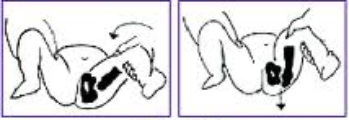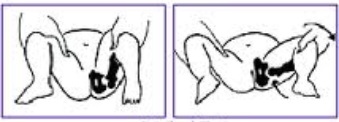Barlow/Ortolani Maneuver
Barlow Maneuver

Image 13
The hip is first flexed and abducted, then gradually adducted with pressure exerted in the posterior direction. Dislocation of the femoral head over the posterior acetabular rim is indicative of an unstable hip. The head of the femur may slide to the edge of the socket (sublux) or dislocate out of the acetabulum.
Ortolani Maneuver

Image 14
The hip is dislocated in a flexion and adduction position. Gentle flexion, abduction, and slight traction reduces the hip. A positive Ortolani sign indicates a more unstable hip than the Barlow sign.
There are mixed reviews on the reliability and validity of the Barlow and Ortolani Maneuvers for determining hip instability in neonates. Experience with this technique makes all the difference. Those examiners that are inexperienced with this technique may have difficulty interpreting their findings.
(3, 9)
